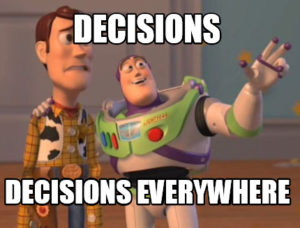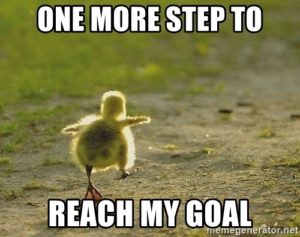
I’m a big fan of the website Effectiviology. It contains articles that draw on research to help people think and reason more effectively.
Today I was reading one of their articles on decision making – https://effectiviology.com/why-its-hard-to-make-decisions/. I thought the content of that post could be neatly summarised in a decision making tool.
The purpose of this tool is to alert you to some of the steps involved in making a difficult or complex decision. Such decisions usually involve bigger life issues like work or study or relationships or life direction or how to respond to challenging scenarios. You are welcome also to use this tool to help you work out what to eat for lunch, but it might be overkill.
The power of a decision making tool is not about following the steps perfectly. It is about subjecting the decision you need to make to additional scrutiny, as we sometimes use shortcuts to making decisions (which don’t necessarily result in great outcomes) or avoid the decision altogether if it is overwhelming.
Step 1 – Identify the decision
Start by recognising that you actually need to make a decision. Even a simple ‘yes/no’ scenario is still a decision. Try to articulate the decision as best you can, including why it is important to make the decision. 
Example – I need to decide whether I am going to continue in my current course or switch courses next year. This will have big implications for my career after uni.
Step 2 – Determine your goals
What are you hoping to achieve by making the decision? You may have more than 1 goal, so ensure you capture all the things you are hoping will come to fruition once the decision is made and how important each of them is to you.
Example – I am hoping that I will enjoy my studies more if I am doing a course that more closely aligns with my interests. I also hope that I will get better grades. I think also that I might be able to get a better job quicker if I shift into a shorter degree.

Step 3 – Gather information
What information do you need in order to make a well informed decision? This might involve doing some research on your own, or talking to someone (an expert) who can provide the relevant information.
Example – I need to find out if I can change courses and if the topics I have completed can count towards the new degree. I also need to find out from someone whether the different course I am thinking of doing is any good (like an existing student).
Step 4 – Identify options
This is where you list out the different options available to you. Start with the obvious options first, but then also try to include some compromise or ‘out of left-field’ options as well. This step is an opportunity to be creative about the choices you could make. Often we frame decisions too simply, when in fact, more nuanced options are the right way through.
Example – I can stick with my current course or shift into the new course or maybe stay in the current course but pick up a couple of extra topics or go part-time and look for work whilst I study or ………..
 Step 5 – Evaluate the options
Step 5 – Evaluate the options
For each option that you identify, write down the strengths and weaknesses (pros and cons) of that option. Refer back to your original goals to remind yourself of what it is you are trying to achieve and evaluate each option in terms of its likelihood in meeting those goals. The analysis process might help you identify other goals you didn’t know were important to you, or other options that you didn’t think of.
Example:
| Pros | Cons | |
| Stick with current course | Know what to expect. Have friends in the course. | Not enjoying it enough. |
| Shift to new course | Might be closer to my interest areas. | Don’t know much about the course other than what I’ve read. |
| Stay with current course but add a few topics | Get to continue with current topic and build on what I’ve already learned but enhance it with content from a new area. | Will be busier and might fall behind. |
| Shift to part-time | Extra time to work and earn money. | Getting degree will take longer. |
Step 6 – Select the preferred option
Based on the options that you’ve explored, pick the option that is both feasible (you think you can do it) and gets you closest to your goals (you may end up revising your goals and this is OK) 🔘. This might be challenging if the options are balanced in their pros and cons. Try visualising the outcomes for each option and see which future you prefer.
Example – Although it surprises me, I guess I really like the idea of working and studying at the same time, even if it takes longer overall. I’ll have the work experience I need and the extra time needed to dig further into my topics which might mean I enjoy them more.
Step 7 – Enact the option
This step is just about following through on the decision you’ve made. For complex decisions you might need to write out a plan if carrying out the decision consists of a series of sub-steps. A plan is simply a list of the steps you’ll take to implement the decision.
Example – I’ve contacted the admissions office and made the change to my enrolment to part-time. I am going to talk to my old boss about picking up some extra hours of work. I will ring them on Friday.
Hit a block?
It is normal to get stuck at some part of the decision making process. This is because life isn’t always as easy as following a simple 7-step method.

Use some of the prompt questions below to help you locate the source of your ‘stuckness’.
- 🔁 Do you need to repeat the process? Perhaps you have not gone into a suitable level of detail at each step, or perhaps in the process you’ve realised that the decision you need to make is not quite what you thought it was.
- Look to see if you have missed out any of these steps or not completed them sufficiently.
- Is fear getting in the way of the decision? 😨 Fear of missing out. Fear of doing something you regret. Fear of hurting someone. Fear of making the wrong decision. It is important to remind yourself that the presence of fear indicates this a decision of significant importance to you. So try to pick the option that most closely represents the person you want to be – your ideal self. And remember also that the level of fear we experience in relation to a decision is almost always more than any negative emotions we experience having made the decision, so take some comfort in the fact that making the decision will likely reduce the negative emotional component.
- Do you find the decision too hard to make? Perhaps you are tired and need to rest first, or perhaps you need to engage a trusted other person to help you sort through the options (friend, colleague, counsellor).
- Try to imagine that you are making the decision for someone you care about, a friend or family member. Does doing this help you identify a better option?
- Have you had to make a similar decision in the past? Could you draw on a past decision you made to help you make this one?
- Are you avoiding examining the decision in detail because it relates to an unpleasant topic? 😔 Perhaps you need to think about how you will manage the unpleasant emotions that go along with the decision making process before digging into the decision itself.
- Is the decision you need to make very complex? Perhaps you need to slow down the process and spend more time at each step. Or perhaps you need to identify an expert (or experts) that you can consult with to ensure you have all the necessary information to make the decision.
- Is there a lot of uncertainty attached to the outcome of the decision, that is, you can’t really predict the outcomes of the different options? In this case you might need to find someone who has made a similar decision before and use their experience to better predict the potential outcomes of your decision.
- Does your decision have potentially very serious consequences? If so, you may need to ensure that you have appropriate supports in place should there be big consequences as a result of your decision.
- Is it a self-confidence issue? Are you struggling to make the decision because of a lack of faith in your own abilities? Really the main thing I can say here is that confidence is built over time, through making such decisions and then accepting and adapting to the consequences. Decisions often precede confidence 😎
- Are you naturally an indecisive person?
- Perhaps you are generally a bit anxious and get nervous about making difficult decisions.
- Perhaps you are a bit perfectionistic and get stuck on always wanting to make the ‘perfect’ choice.
- Perhaps you are a procrastinator and tend to put off making important decisions.
- In all three cases, you might find value in being quite deliberate in pushing yourself to work through the steps outlined in this tool, to keep you on track as you make your decision.
- Are you oversimplifying the decision and not exploring alternative or compromise options? Humans often engage in ‘all-or-nothing’ thinking meaning we limit options to two radically opposed viewpoints. Make sure you explore options that represent compromises between the two opposite ends of the spectrum.
- What does your intuition say is the right answer? The ‘gut’ isn’t always right, but it is worth checking in on what does your heart or your gut tell you in the right decision? 💜
- Are you quite emotional at the moment? 😠 Emotions can give us useful information when evaluating the different options available to us, but it isn’t usually wise to make decisions when feeling very negative or very positive.
- Do you feel under pressure because you need to make a decision quickly? ⏱️ If this is the case, limit the amount of information you gather, seek quick counsel from experts and try to come from the stance of making a decision that is ‘good enough’, not necessarily perfect.
- Not sure what the outcomes of each option will be? Try to visualise different futures in which you’ve chosen the different options. Try to imagine the chain of events that will follow if you take each option.
- Are you delaying the decision by spending time gathering information? This is often what those with perfectionist tendencies will do. They assume that the more information they get, the more likely their decision will be ‘perfect’. If this is the case, step away from the information gathering stage and instead focus on visualising the different options you already have.
Closing thoughts
We make probably hundreds or thousands of decisions each day. Very few of the decisions we make involve us going through a process like the one described above.
But we’ll all come across situations in our lives where we are forced to really sit and reflect on a decision we need to make.
When such a situation arises, it can help to utilise a decision making tool, to increase the likelihood that you’ll approach the decision in a systematic way, rather than a haphazard or superficial way.
As I learn more about decision making, I’ll try to update the decision making tool to increase its precision and usefulness. In the meantime, I hope you find the tool helpful. At a minimum I hope it encourages you to consider all dimensions of a decision and ultimately make choices that get you closer to your goals.
Learn more
Read the following articles if you want to dig into this topic a little more:
Why It’s Hard to Make Decisions (Especially Good, Fast Ones)
How to Make Decisions: A Guide for When You Can’t Choose
https://psyche.co/guides/how-to-make-a-tough-decision-break-it-down-and-listen-to-your-gut

